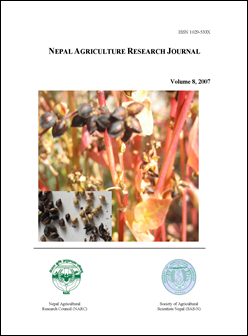Use of Fertilizers and Lime for Enhancing Productivity of Maize Genotypes in Western Hill of Nepal
DOI:
https://doi.org/10.3126/narj.v8i0.11578Keywords:
Agriculture lime, farmer's practice, yield increase, Zea maysAbstract
Farmers' field experiment was conducted at Outreach sites in Tanahun and Palpa districts of Western Nepal with the objectives of evaluating the effects of fertilizers and agricultural lime on grain production of the local and improved (Manakamana-1) maize varieties during summer season of year 2003 and 2004. Farmer's practice (without fertilizers) and with fertilizer 60: 30: 30 kg (N: P2O5: K2O) per hectare with or without agricultural lime (4 t ha-1), were the treatments in experimental study that was conducted in factorial RCB design with four farmers as replications. The results revealed that response of fertilizers and agricultural lime was observed significant plant growth and kernels production including varieties in both sites of Palpa and Tanahun districts. The highest grain yield of 5.1 t ha-1 was produced by the local variety when the crop was supplied with 60:30:30 kg N, P2O5 and K2O ha-1 along with 4 t ha-1 of agricultural lime in Tanahun. Manakamana-1 variety produced the maximum grain yield (4.45 t ha-1) with the same level of fertilization. The two district mean grain yield result indicated that the highest grain yield of 3.9 t ha-1 was produced when the crop was supplied with 60: 30: 30 kg N, P2O5 and K2O ha-1 with agri-lime. Hence it is suggested that to increase maize productivity in the hills irrespective of the maize variety application of fertilizers (60: 30: 30) with agricultural lime (4 t ha-1) is needed.
Nepal Agric. Res. J. Vol. 8, 2007, pp. 42-49
Downloads
Downloads
Published
How to Cite
Issue
Section
License
This license allows reusers to copy and distribute the material in any medium or format in unadapted form only, for noncommercial purposes only, and only so long as attribution is given to the creator.




